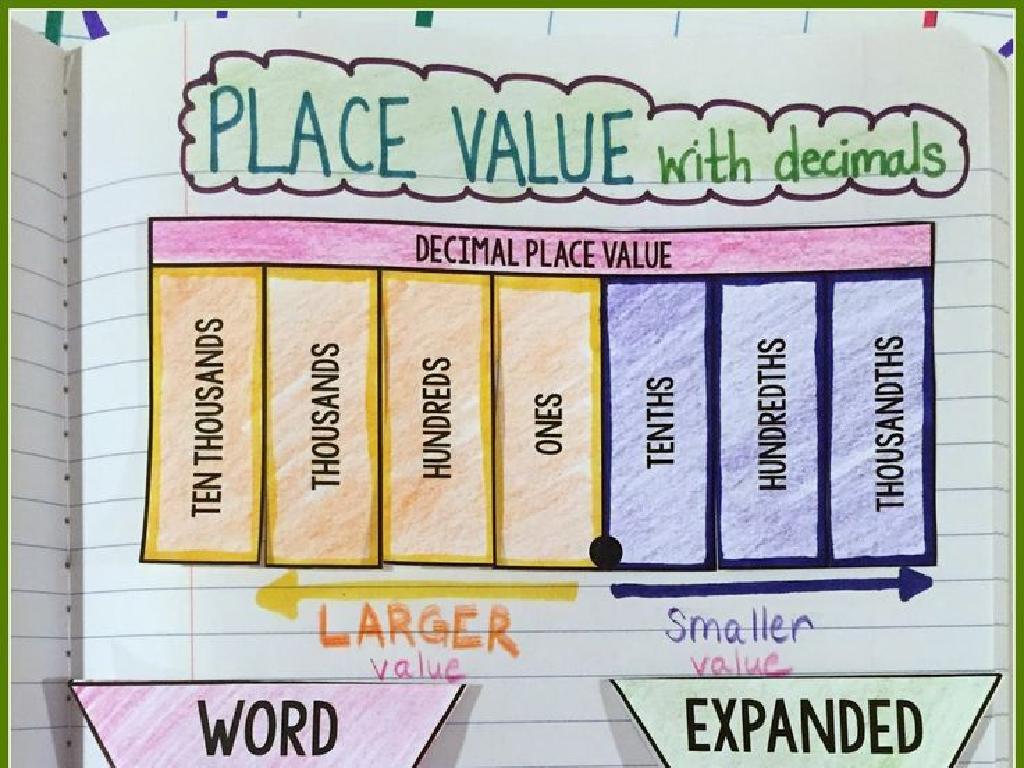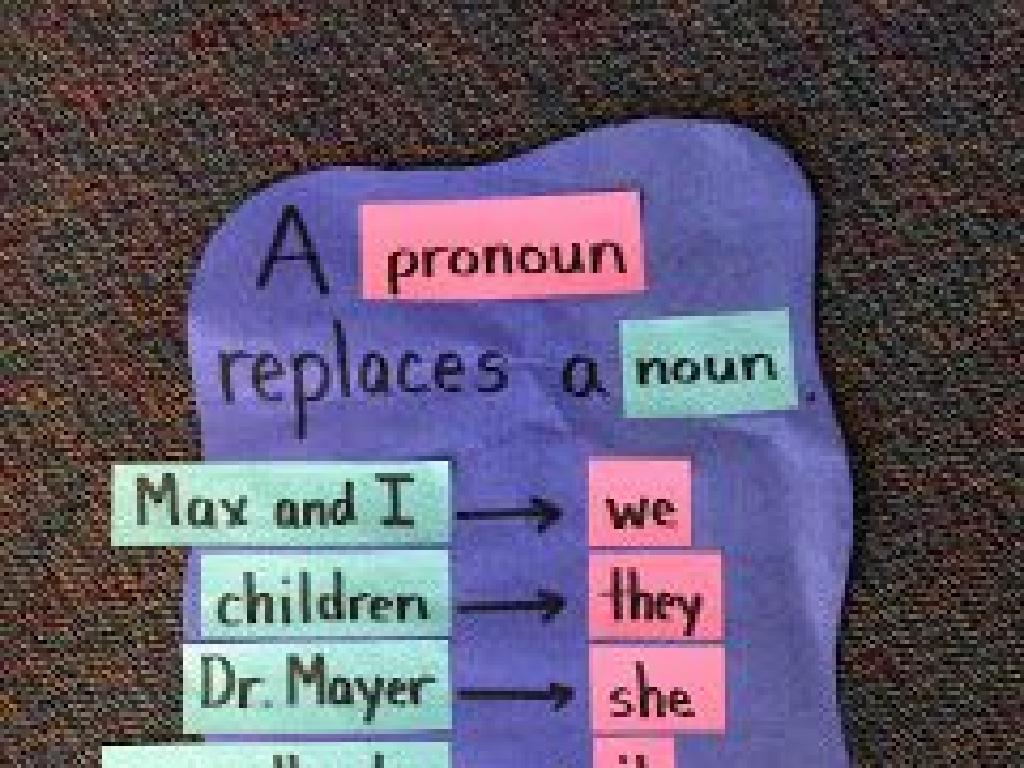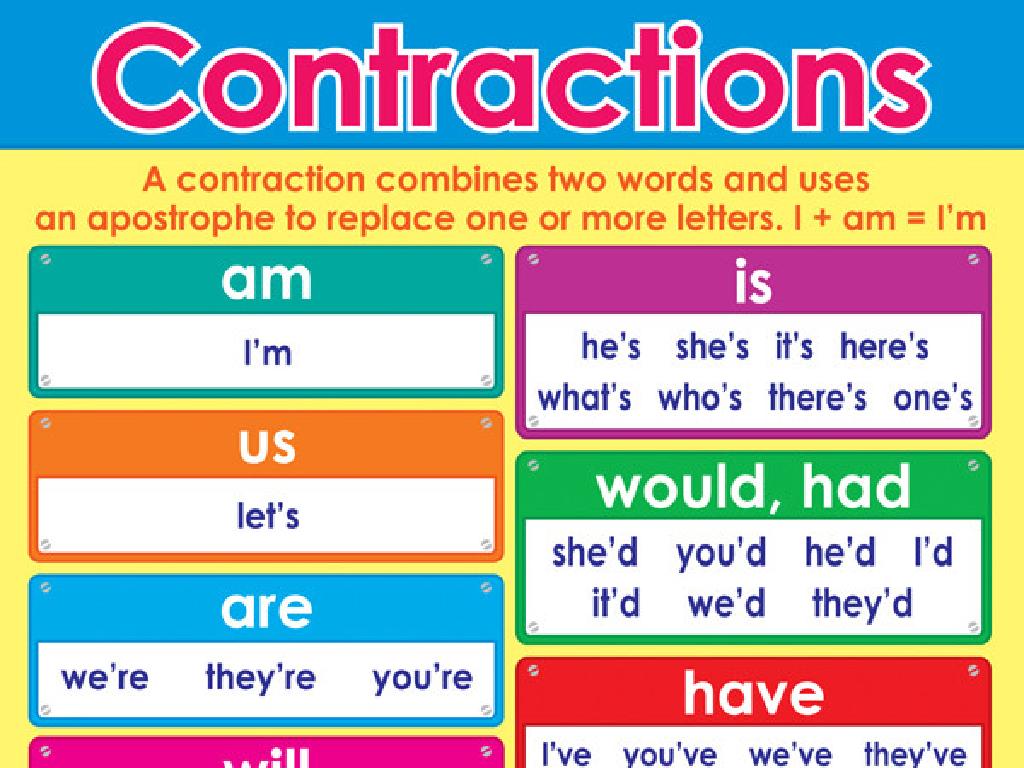Divide Whole Numbers By Unit Fractions
Subject: Math
Grade: Fifth grade
Topic: Divide Unit Fractions And Whole Numbers
Please LOG IN to download the presentation. Access is available to registered users only.
View More Content
Introduction to Fractions: Division Basics
– Recap: Definition of a fraction
– A fraction represents a part of a whole
– Numerator vs. denominator
– Top number is the numerator, bottom is the denominator
– Multiplication with fractions
– Multiplying fractions: multiply the numerators, then the denominators
– Transition to division with fractions
|
Begin with a quick review of what a fraction is, ensuring students recall that it represents a part of a whole. Clarify the roles of the numerator and denominator, with the numerator indicating how many parts we have and the denominator showing the total number of equal parts in the whole. Then, review the process of multiplying fractions, which involves multiplying the numerators together to get the new numerator, and the denominators to get the new denominator. This will set the stage for understanding how division of whole numbers by unit fractions can be thought of as the inverse of multiplication.
Understanding Division with Fractions
– What division with fractions means
– Dividing by a fraction finds how many of these fractions make up a whole number.
– Division: How many times one number fits
– If you have 3 pizzas and 1/2 pizza per person, how many people can eat?
– Division relates to multiplication
– Multiplying by the reciprocal gives the same result as division.
– Practice with real examples
– Let’s divide 4 by 1/2. How many halves in 4 whole?
|
This slide introduces the concept of dividing whole numbers by unit fractions. Start by explaining that division with fractions helps us find out how many pieces of a certain size are in a whole. Relate division to multiplication by showing that dividing by a fraction is the same as multiplying by its reciprocal. Use real-life examples like sharing pizzas to make the concept relatable. Encourage students to think of division as the process of finding out how many times a divisor can fit into the dividend. Provide practice problems to solidify their understanding, such as dividing a whole number by a unit fraction and interpreting the result.
Dividing Whole Numbers by Unit Fractions
– Understanding unit fractions
– A unit fraction has 1 as the numerator, like 1/2, 1/3, 1/4.
– Steps to divide by a unit fraction
– Invert the fraction and multiply with the whole number.
– Example: Divide 5 by 1/2
– 5 ÷ 1/2 turns into 5 x 2/1, which equals 10.
|
Begin by explaining what a unit fraction is, emphasizing that it’s a fraction with a numerator of 1. Then, demonstrate the process of dividing a whole number by a unit fraction by inverting the fraction and turning the division into multiplication. Use the example of dividing 5 by 1/2 to show that 5 divided by 1/2 is the same as 5 times 2, which equals 10. This concept can be tricky, so ensure to provide clear explanations and encourage students to practice with different numbers to solidify their understanding.
Visualizing Division with Unit Fractions
– Visual models aid division understanding
– Example: Dividing 6 by 1/3 using a bar model
– Imagine a bar split into 3 equal parts; how many groups of 1/3 are in 6?
– Explore dividend, divisor, quotient relationship
– Dividend is what we divide, divisor is the unit fraction, quotient is the result
– Understanding division as repeated subtraction
– Division can be seen as how many times we subtract the divisor from the dividend
|
This slide is aimed at helping students visualize the process of dividing whole numbers by unit fractions. Start by explaining that visual models, like bar models, can make abstract concepts more concrete. Show an example of dividing 6 by 1/3 by drawing a bar and dividing it into thirds to find out how many one-thirds are in six. Discuss how the dividend (6) is the number being divided, the divisor (1/3) is the unit fraction we divide by, and the quotient is the answer we get. Emphasize that division can also be understood as repeated subtraction, which can be a helpful strategy for students. Encourage students to draw their own models and use them to solve similar problems.
Dividing Whole Numbers by Unit Fractions
– Solve 8 ÷ 1/4 together
– How many 1/4s are in 8?
– Solve 10 ÷ 1/5 together
– How many 1/5s are in 10?
|
This slide is designed for a collaborative classroom activity where students will practice dividing whole numbers by unit fractions. Start by explaining that dividing by a fraction is the same as multiplying by its reciprocal. For Problem 1, guide the students to understand that 8 ÷ 1/4 asks how many quarter units fit into 8. The answer is found by multiplying 8 by the reciprocal of 1/4, which is 4, resulting in 32. Similarly, for Problem 2, demonstrate that 10 ÷ 1/5 can be solved by multiplying 10 by the reciprocal of 1/5, which is 5, giving the answer 50. Encourage students to visualize the division as a ‘how many times does this fraction fit into the whole number’ problem. This conceptual approach helps students grasp the idea of division involving fractions.
Strategies for Dividing by Unit Fractions
– Use multiplication for division
– Instead of dividing, multiply by the inverse of the fraction
– Invert the divisor to multiply
– Flip the unit fraction and then multiply
– Shortcut: Multiply by reciprocal
– Reciprocal of 1/5 is 5/1, so multiply by 5
– Practice with examples
|
When teaching division of whole numbers by unit fractions, it’s crucial to help students understand that division can be turned into a multiplication problem. Emphasize the strategy of inverting the divisor, which means flipping the unit fraction, to convert the division into multiplication. For example, dividing by 1/5 is the same as multiplying by its reciprocal, 5. Provide several examples for the students to practice this method, such as 6 ÷ 1/3 = 6 x 3 = 18. Encourage students to explain the process in their own words and to use this shortcut to solve problems more efficiently. This slide should serve as a guide for students to reference the steps and practice the strategy with different numbers.
Class Activity: Fraction Division Relay
– Split into small groups
– Each group receives division problems
– Solve the problems as a team
– Work together to divide whole numbers by unit fractions
– First team to finish wins!
|
This activity is designed to encourage teamwork and reinforce the concept of dividing whole numbers by unit fractions. Before starting, ensure that each group understands the process of division involving fractions. Provide each group with a set of problems that require them to divide whole numbers by unit fractions. Monitor the groups as they work, offering guidance as needed. The first team to correctly complete all their problems wins the relay. Possible variations of the activity could include using different levels of difficulty for each group based on their proficiency, incorporating a mix of division and multiplication of fractions, or having a ‘challenge’ problem that is worth extra points.
Wrapping Up: Division with Unit Fractions
– Recap of dividing whole numbers by fractions
– Homework: Complete the worksheet
– Worksheet has problems to solve at home
– Practice makes perfect
– Regular practice will help you master the concept
– Bring any questions to next class
– We’ll review any difficulties in our next session
|
As we conclude today’s lesson on dividing whole numbers by unit fractions, it’s important to summarize the key points and ensure students understand the process. For homework, students are assigned a worksheet that provides additional practice to reinforce the concept. Encourage students to practice at home to achieve mastery. Remind them that it’s okay to have questions and that they should bring any challenges they face to the next class for clarification. This will help them feel supported and motivated to learn.





